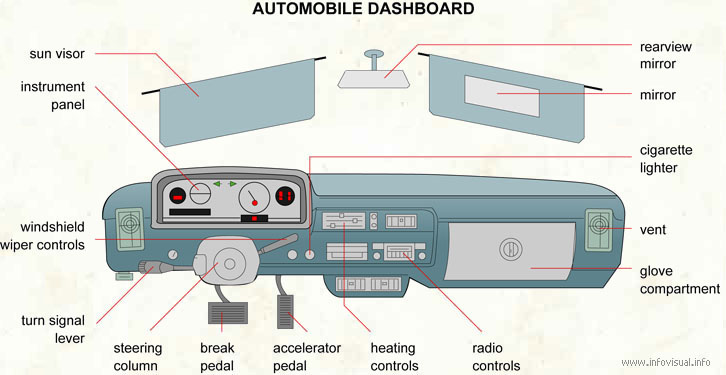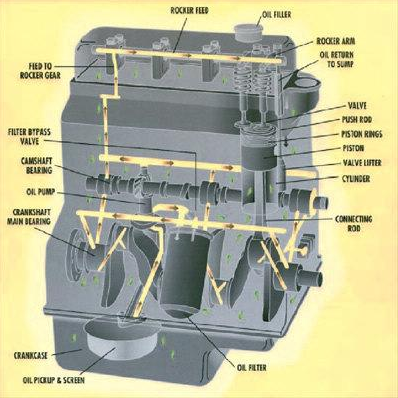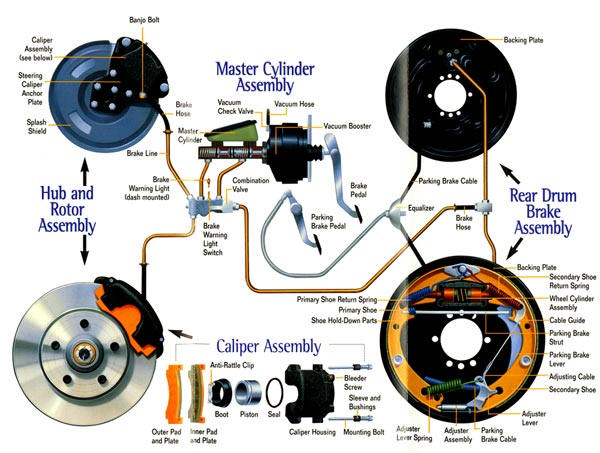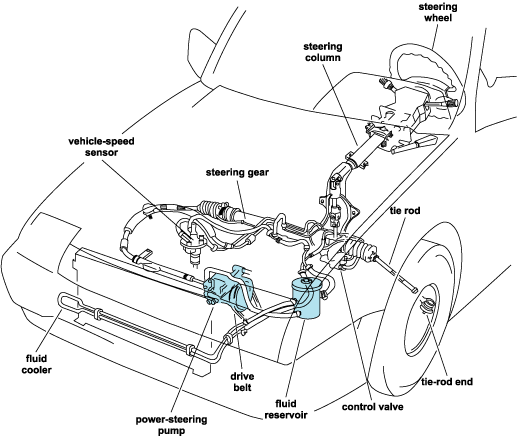
- •Answer these questions:
- •Are the following statements true or false?
- •Match words from the two boxes to find the exterior car parts:
- •Complete the sentences with the following words (exterior design):
- •Complete the sentences with the following words (interior design):
- •Here are some factors people consider buying a car. Match the factors with the definitions.
- •Read and translate this extract in written form.
- •Study the following information:
- •Complete the text ‘a handmade car’ with the following words.
- •Find the words hidden in the jumbles.
- •Internal combustion engine
- •Work with your partner to describe position of car components. Use the following phrases:
- •Match English word combinations with their equivalents in Ukrainian:
- •Match the word with its definition:
- •Translate this extract in written form:
- •Describe the components from the box below using words used to describe shape of car parts.
- •Find the words hidden in the jumbles.
- •Complete the text (a tour of a car factory) with the following words:
- •Complete the table:
- •Now complete the sentences with the words from the table:
- •Read and translate this extract:
- •Study the following information:
- •Match the words from these two boxes to make expressions:
- •Study the following information:
- •Match the expressions above with the following definitions:
- •Translate the sentences into Ukrainian:
- •Work in small groups to have the following meeting:
- •Complete the sentences about materials with words given below :
- •Translate this extract in written form:
- •Read and discuss the following passage. What do you know about traffic rules of our country? Do you obey them?
- •Answer these questions:
- •Complete the table:
- •What car parts are made of what materials? Pay attention to glass, leather, plastic, rubber, steel, textile, wood and others.
- •Read “The Mini Story”. Which three paragraphs are from the same article and which one is from a fashion magazine? Put the paragraphs from the article in the correct order.
- •Answer these questions:
- •Here are some factors people consider when buying a car. Match the factors with the definitions.
- •Are these sentences about the text true (t) or false (f)?
- •Find the words hidden in the jumbles:
- •Match these English phrases with their equivalents in Ukrainian:
- •Now use the expressions above to complete the sentences and translate them into Ukrainian:
- •Match the words and phrases to the correct headings.
- •Put the safety features into the correct column. Which of these safety features does your or your parents’ car have?
- •Match the questions (1 – 7) with their answers (a – g):
- •Imagine you are a transport consultant brought in to advise it on how to make cars safer. Prepare and deliver a presentation of your recommendations to the representatives of the design department.
- •Fill the missing words in. The first one has been done for you. Use them in the sentences of your own.
- •Read and translate this extract in written form:
- •Rewrite the sentences with a participle clause instead of a relative one.
- •Which instrument shows you:
- •Translate the following extract in written form:
- •Find the words hidden in the jumbles.
- •Match each column of the English words with its Ukrainian equivalent.
- •Translate these sentences into Ukrainian. Find the Infinitive and state its function.
- •What are your predictions for the next ten years for instruments and switches of the car? Prepare a short report or presentation.
- •Do you think the materials are clever, fashionable or formal? Read the text about ‘Smart materials’ and check.
- •Choose the correct answer:
- •Work with your partner. Choose one of the smart materials in the text. Think of five interesting ways it could be used. Compare your ideas with other students.
- •Find a better and cheaper way to produce parts and the auto industry takes notice! For example, hydroformed parts offer weight, design and cost advantages over stampings.
Match the words from these two boxes to make expressions:
Urban, Cd, running, resale, braking, boot, front, disk, kerb |
Costs, consumption, brakes, capacity, distance, suspension, value, value, weight |
Study the following information:

Automobile dashboard: the control panel of a car. Contains gauges used to measure speed, distance traveled, etc. It is generally located in front of the driver.
Rearview mirror: mirror used for looking backward.
Cigarette lighter: device used for lighting cigarette.
Vent: opening that allows air to circulate in the passenger compartment.
Glove compartment: storage compartment at the front of passenger compartment.
Radio controls: button used to control the radio.
Heating controls: button used to control the different heating systems of a car.
Steering column: set of mechanisms used for steering a car.
Turn signal level: control that operates the turn signals.
Windshield wiper controls: hand lever controlling the windshield wiper.
Instrument panel: set of dials and pictograms that give information on the state of a vehicle.
Sun visor: movable device that shields against the sun.
Match the expressions above with the following definitions:
A measure of the car’s wind resistance or drag coefficient.
The amount you spend on petrol, tax, maintenance, …
A volume of the boot.
Haw much fuel you need driving around town.
Brake system which uses a caliper and rotor, or disc, to stop or slow a vehicle.
How much you can expect to get if you sell the car after three years.
The connection of the axles by springs and dampers to the car body which prevents occupants from feeling road shocks.
The distance between putting your foot down on the brake and the car stopping.
How much the car weighs when there are no passengers in it and with half a tank of fuel.
Translate the sentences into Ukrainian:
The front suspension has been stiffened to produce more precise steering at high speeds.
We have also increased the size of the disc brakes for a shorter braking distance.
I also noticed that the press release says there is improved fuel consumption.
Firstly, we have enhanced the Cd value with a new design.
We have also reduced the weight of the car by over 50 kilos by using light-weight materials.
We have introduced a start-stop automatic so that the engine cuts out if you stand still for more than three seconds and starts again when you take your foot off the brake.
This has a positive effect on the running costs of his car and on the resale value.
We have also increased the boot capacity to make the car more practical for families and sports people.
THE LUBRICATING (OILING) SYSTEM

There are many places in an engine where metal rubs against metal. For example, the piston rings rub against the cylinder walls; the crankshaft rubs against the inside of the big end. When this happens, the metal gets hot. This rubbing together of metal (friction) and the heat cause the engine to wear. This friction can be made less by using oil. There is a large container (the sump) at the bottom of the engine. The sump holds over 1 gallon (4.5litres) of oil. Many pipes and holes go from the sump. The oil flows through these to places where there is friction; the cylinder, the crankshaft. A pump in the sump pumps the oil to these places. The pump is worked by the camshaft.
THE TRANSMISSION SYSTEM
The transmission system carries (transmits) the movement of the crankshaft to the wheels. It has three main parts: the change gears; the clutch; the rear axle gears. A gear is only a strong steel wheel with teeth. If a small gear with 25 teeth turns twice, it will turn a gear with 50 teeth once. This is a low gear. If a large gear with 50 teeth turns once, it will turn a gear with 25 teeth twice. This is a high gear. Gears can have as many teeth as are needed. The crankshaft of a car engine can turn as fast as 6,000 times a minute. One turn is a revolution. So that is 6000 revolutions per minute (rpm). This speed is too great to transmit straight to the wheels. It is made less by two things:
1. The change gears.
2. The differential gears in the back axle.
The change gears
In the gearbox there are three shafts: 1. the driving shaft is turned by the crankshaft. It has a fixed gear wheel near its end. 2. The driven shaft leads to the back axle. On this shaft there are two gears. One gear is larger than the other. These gears can move along the shaft in grooves. They can move backwards and forwards. They are moved by the gear lever. 3. The lay shaft. Four gears of different sizes are fixed on this shaft. The largest always meshes with the gear on the driving shaft. So, when the engine is running the lay shaft must be turning. It must also turn more slowly than the driving shaft. Its gear is larger. The gear box is about half full of oil.
First of bottom gear
First gear: The large gear on the driven shaft meshes with the smaller forward gear on the lay shaft. The engine is running fast but the driven shaft and the wheels turn slowly. This gear is used to start the car moving.
Second gear
Second gear: The smaller gear on the driven shaft mashes with the second largest gear of the same size. The one on the lay shaft is only a little smaller. This gear is used to increase the speed of the car.
Top gear
Top gear: the driving shaft joins straight on to the driven shaft. The car is now moving very fast. There is little difference between the engine speed and the speed of the wheels. If the car has to slow down, the driver will have to change to a lower gear.
THE BRAKES
When the brake pedal is pushed down, it forces oil (hydraulic fluid) through small pipes. These pipes lead to the brakes. A drum is fixed to each wheel. This goes round with the wheel. The fluid forces the brake shoe to rub against the drum. There are also disc brakes. A metal disc is fixed to each wheel. The fluid forces a pad to rub against the disc. The friction between the brake shoe and the drum, or the pad and the disc, slows down the wheel.
Springs on the axles give a smooth movement to the car body. Two kinds of springs are used. They are leaf springs and coil springs. Leaf springs are unusually on back axles. Coil springs are on front axles.
Shock
absorbers filled with oil also help. These go in and out telescopes.
When the vehicle goes over a bump, the spring compresses and expands and will continue to compress and expand several times before returning to its original position. A similar action is seen when a rubber ball is dropped on the floor. This additional action is undesirable and results in an uncomfortable ride. To reduce this additional action shock absorbers are fastened between the axle and the frame. Most late-model shock absorbers consist of a telescoping tube partially filled with a fluid that can pass through a restricted passage from one part of the tube to the other. When the tube is compressed or expanded, the fluid causes a showing down action on the telescoping tube.
STEERING SYSTEM
T he
steering is the mechanism by which a car can be guided along the road
and steered in the direction the driver wishes to travel.
he
steering is the mechanism by which a car can be guided along the road
and steered in the direction the driver wishes to travel.
Each front wheel is mounted, on a “stub” axle which is able to swivel on a nearly upright spindle called the “king-pin”. Fitted to each stub axle is a short lever known as the “steering arm”, the two steering arms being connected together across the front of the car by a “track-rod”.
Projecting from the steering box” is a short lever called the “drop arm”, and this can be connected to the off-side wheel (the wheel on the driver’s side of the car) by means of a “drag-link”, or directly to the track rod as shown in the illustration.
When the driver turns the steering wheel, mechanism in the steering box causes the drop arm to move forward or backward. This movement results in the movement of the steering arm and the turning of the road wheel. The steering usually operates directly on the offside wheel, the track rod making sure that the other wheel exactly follows the movement.
Many cars are fitted with an alternative method of steering called “rack and pinion”. This is very efficient, but unless care is taken in the design, road jolts can affect the steering.
